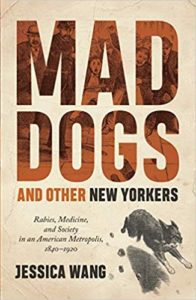 When I reviewed Timothy P. Barnard’s Imperial Creatures: Humans and Other Animals in Colonial Singapore, 1819–1942, I was struck by what a large role rabies played in the story. While Singapore is now wholly free of the disease, the threats, challenges, and public fear it caused to the island nation in the nineteenth and early twentieth century were severe.
When I reviewed Timothy P. Barnard’s Imperial Creatures: Humans and Other Animals in Colonial Singapore, 1819–1942, I was struck by what a large role rabies played in the story. While Singapore is now wholly free of the disease, the threats, challenges, and public fear it caused to the island nation in the nineteenth and early twentieth century were severe.
So when I noted Jessica Wang‘s Mad Dogs and Other New Yorkers; Rabies, Medicine, and Society in an American Metropolis, 1840–1920 being recently published by Johns Hopkins University Press, I immediately wished to discover if she found similar challenges from the disease to have faced that named city during the same period of time in the past.
While Prof. Barnard did present a considerable amount of information about the disease and its effects in Singapore during his period of historical focus, in truth it wasn’t a central topic to his book. Prof. Wang explores it much more extensively in hers, both as a disease in itself as well as using it as a central point of departure to explore a number of other related lines of inquiry – particularly social geography and the development of medicine during the period.
If you enjoyed reading this, please consider signing up for The Well-read Naturalist's newsletter. You'll receive a helpful list of recently published reviews, short essays, and notes about books in your e-mail inbox once each fortnight.
